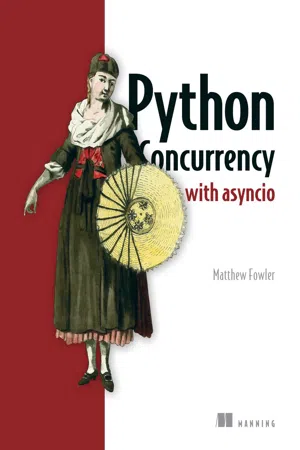
- 376 pages
- English
- ePUB (mobile friendly)
- Available on iOS & Android
Python Concurrency with asyncio
About this book
Learn how to speed up slow Python code with concurrent programming and the cutting-edge asyncio library. Use coroutines and tasks alongside async/await syntax to run code concurrently
Build web APIs and make concurrency web requests with aiohttp
Run thousands of SQL queries concurrently
Create a map-reduce job that can process gigabytes of data concurrently
Use threading with asyncio to mix blocking code with asyncio code Python is flexible, versatile, and easy to learn. It can also be very slow compared to lower-level languages. Python Concurrency with asyncio teaches you how to boost Python's performance by applying a variety of concurrency techniques. You'll learn how the complex-but-powerful asyncio library can achieve concurrency with just a single thread and use asyncio's APIs to run multiple web requests and database queries simultaneously. The book covers using asyncio with the entire Python concurrency landscape, including multiprocessing and multithreading. About the technology
It's easy to overload standard Python and watch your programs slow to a crawl. Th e asyncio library was built to solve these problems by making it easy to divide and schedule tasks. It seamlessly handles multiple operations concurrently, leading to apps that are lightning fast and scalable. About the book
Python Concurrency with asyncio introduces asynchronous, parallel, and concurrent programming through hands-on Python examples. Hard-to-grok concurrency topics are broken down into simple flowcharts that make it easy to see how your tasks are running. You'll learn how to overcome the limitations of Python using asyncio to speed up slow web servers and microservices. You'll even combine asyncio with traditional multiprocessing techniques for huge improvements to performance. What's inside Build web APIs and make concurrency web requests with aiohttp
Run thousands of SQL queries concurrently
Create a map-reduce job that can process gigabytes of data concurrently
Use threading with asyncio to mix blocking code with asyncio codeAbout the reader
For intermediate Python programmers. No previous experience of concurrency required. About the author
Matthew Fowler has over 15 years of software engineering experience in roles from architect to engineering director.Table of Contents
1 Getting to know asyncio
2 asyncio basics
3 A first asyncio application
4 Concurrent web requests
5 Non-blocking database drivers
6 Handling CPU-bound work
7 Handling blocking work with threads
8 Streams
9 Web applications
10 Microservices
11 Synchronization
12 Asynchronous queues
13 Managing subprocesses
14 Advanced asyncio
Frequently asked questions
- Essential is ideal for learners and professionals who enjoy exploring a wide range of subjects. Access the Essential Library with 800,000+ trusted titles and best-sellers across business, personal growth, and the humanities. Includes unlimited reading time and Standard Read Aloud voice.
- Complete: Perfect for advanced learners and researchers needing full, unrestricted access. Unlock 1.4M+ books across hundreds of subjects, including academic and specialized titles. The Complete Plan also includes advanced features like Premium Read Aloud and Research Assistant.
Please note we cannot support devices running on iOS 13 and Android 7 or earlier. Learn more about using the app.
Information
1 Getting to know asyncio
- What asyncio is and the benefits it provides
- Concurrency, parallelism, threads, and processes
- The global interpreter lock and the challenges it poses to concurrency
- How non-blocking sockets can achieve concurrency with only one thread
- The basics of how event-loop-based concurrency works
1.1 What is asyncio?
yield from syntax to define coroutines. A coroutine is a method that can be paused when we have a potentially long-running task and then resumed when that task is finished. In Python version 3.5, the language implemented first-class support for coroutines and asynchronous programming when the keywords async and await were explicitly added to the language. This syntax, common in other programming languages such as C# and JavaScript, allows us to make asynchronous code look like it is run synchronously. This makes asynchronous code easy to read and understand, as it looks like the sequential flow most software engineers are familiar with. asyncio is a library to execute these coroutines in an asynchronous fashion using a concurrency model known as a single-threaded event loop.async and await syntax with threads and processes making these workflows easier to understand. This means this library not only is good for I/O based concurrency but can also be used with code that is CPU intensive. To better understand what type of workloads asyncio can help us with and which concurrency model is best for each type of concurrency, let’s explore the differences between I/O and CPU-bound operations.1.2 What is I/O-bound and what is CPU-bound?
import requests response = requests.get('https:/ / ...Table of contents
- inside front cover
- Python Concurrency with asyncio
- Copyright
- dedication
- contents
- front matter
- 1 Getting to know asyncio
- 2 asyncio basics
- 3 A first asyncio application
- 4 Concurrent web requests
- 5 Non-blocking database drivers
- 6 Handling CPU-bound work
- 7 Handling blockingwork with threads
- 8 Streams
- 9 Web applications
- 10 Microservices
- 11 Synchronization
- 12 Asynchronous queues
- 13 Managing subprocesses
- 14 Advanced asyncio
- index
- inside back cover